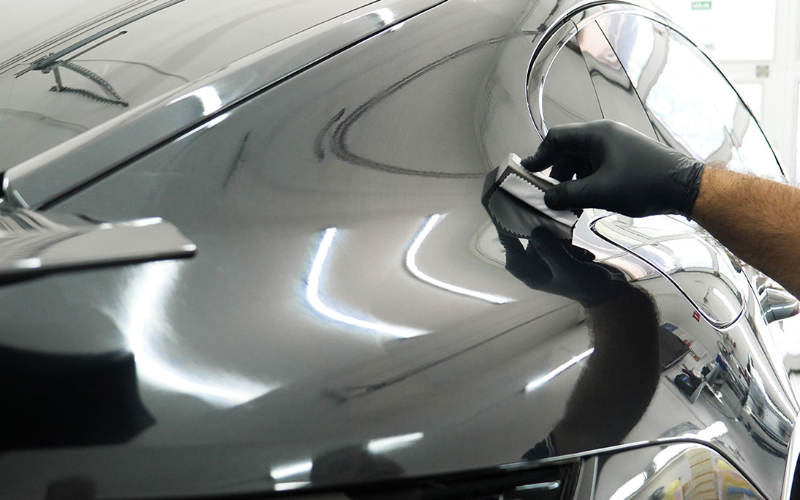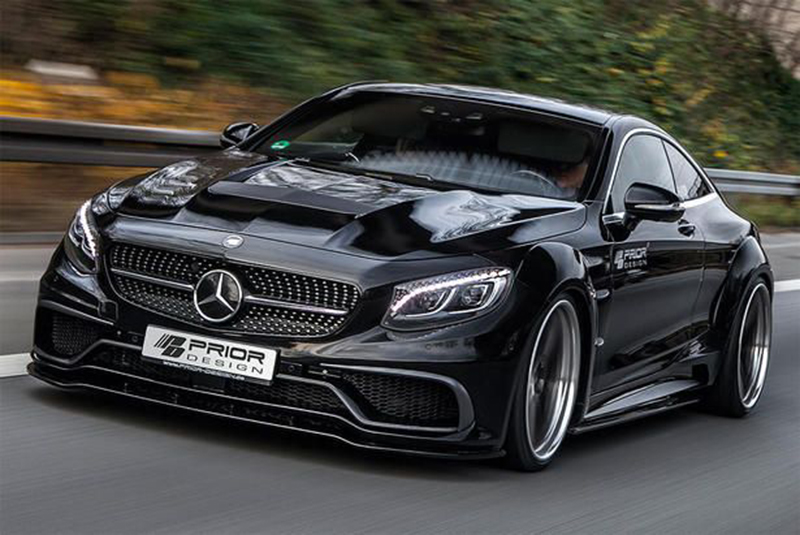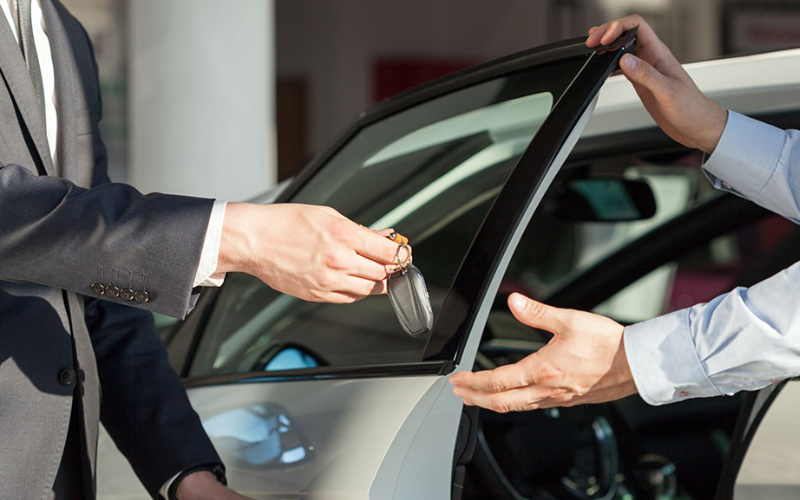Protecting your car’s paint is a serious business. When you’re buying a new car, the standard paint options are often quite dull. If you want to inject some color or metallic effect, then you invariably have to spend additional money, sometimes more than $1,000 if your car is a premium brand.
All of this means that protecting that paint has become a top priority for most car owners. Not only does it cost to get the paint in the first place, but paint repairs and repainting jobs cost a fortune as well. Forbes.com estimated that paint correction in the US can cost anywhere from $500 to $2,500 depending on the extent of the damage.
How are we then to protect our car’s paint? Two of the best options out there are paint protection film (PPF) and ceramic coatings. Neither of these options is cheap, and many wonder about the exact benefits of each one. They seem to both be held up as the paragon of car paint protection, but the truth is that there’s a lot more to it. This is what today’s blog is all about.
Paint Protection: An Introduction
There are many ways that people use to protect their car’s paint. The most common and certainly the most affordable is to simply apply a layer of wax to the paint’s surface after detailing. Wax doesn’t provide much physical protection, but synthetic waxes and sealants can provide effective protection against all things chemical and water based. If you’re mostly concerned about things like bird droppings, tree sap, dirty city rainfall and similar contaminants, then a good layer of synthetic wax is a strong protection.
Another more “hardcore” way to protect your paint is with a vinyl wrap. These can dramatically alter the look of a car, of course, but in terms of physical protection, it doesn’t get much better than a vinyl wrap. It involves essentially placing a vinyl shell around the vehicle that covers up the original paint and therefore protects it from all manner of damage save for major collisions. Besides being protective, some drivers opt for vinyl wraps because of the aesthetic features they bring to the vehicle.
These are two far ends of the spectrum from the most basic to the most extreme in terms of protection. Car waxing can prove too tiresome and time-consuming for some people, however, and others would like to protect their paint without actually covering it with another color scheme. For this type of car owners, we have PPF and Ceramic Coating.
Paint Protection Film
What is Paint Protection Film (PPF)?
Paint protection film, often abbreviated to PPF, is a layer of thermoplastic urethane that comes with a number of incredible properties that serve to protect the car’s paint underneath. PPF also has some other interesting names:
- Clear bra
- Clear film
- Clear paint film
It is widely OEM-approved by car manufacturers, and is mostly applied to areas of the car that are most at risk of impact from rock chips and other loose debris that you might typically find on the road. Unlike other forms of paint protection which are focused on creating liquid polymer layers of protection, PPF creates a physical barrier between the paint and outside debris, but without having to resort to anything as extreme as a full vinyl wrap.
PPF has its origins in the military. It was used by the army in the Vietnam War on helicopter rotor blades and other sensitive components to protect them from shrapnel and other flying debris that could emerge in the heat and chaos of battle. It was first developed for the US military by 3M. As with many products that were first developed for this kind of military or government use, it eventually filtered down into the consumer market and has been applied to machinery a lot more everyday than a military helicopter or other transport aircraft.
What Are the Benefits and Drawbacks of PPF?
Benefits
The potential benefits of PPF are many. First of all it offers a great layer of physical protection against rocks, salt, loose bits of wood and other debris on the roads. While it isn’t an impervious shield, it is far better as a layer of protection than anything based on wax, sealant or even ceramic coating. When it comes to this kind of debris, the roads can be unpredictable. Even if we take steps to adjust our own speed and ensure that this debris doesn’t fly up at us from our own driving, it can still be cast upon us by other drivers.
Another benefit of PPF is its incredible self-healing property. Not all PPF has this, but the modern multi-layered products do, and it’s the very top layer of the film that can reform itself after being scratched or otherwise scuffed. This allows the PPF to maintain its clarity for up to 10 years. The self-healing effect is achieved through a process called microreplication. Contrary to what your eyes see, the scratches and scuffs are not actually removed when the PPF self-heals. Microreplication just means that other layers underneath the top scratched layer come to rearrange themselves in such a way that dissipates the scratch and makes it invisible to the eye. You’ll notice the effect when the heat of the sun is left on a scratch, or if you warm it with a heat gun.
Besides the physical protection and self-healing capabilities, PPF also contains many of the benefits of other paint protection methods such as ceramic coating. It creates a hydrophobic surface that causes any water hitting the surface to simply bead and run off. To enhance this effect further, you can apply ceramic coating to the PPF itself. Besides that, you get the same protection against chemicals and other liquid-based contaminants against which ceramic coatings also offer decent protection.
One final benefit of PPF is that because it is clear, you can retain the original color of your car while protecting it. When you resort to something like a vinyl wrap, you make a drastic change to the way the car looks. There are other benefits to vinyl wrap, but those who want to retain their car’s original OEM color and still enjoy the protection can get that from PPF.
Drawbacks
We won’t list cost as a downside to PPF since all high-level paint protection methods are an expensive process. Both PPF and ceramic coating work as an investment for your car, so we’ll take the cost as read.
The first real drawback of PPF is the lack of aesthetic benefit. We mentioned above that one benefit of the way it looks is that PPF allows you to retain your car’s OEM color. While this is certainly true, it doesn’t provide an additional layer of glorious shine or gloss like ceramic coating does. If you’ve ever seen a car on the street that looks like it just rolled out of a showroom somewhere, then there’s a good chance that it has been enhanced with ceramic coating.
Another drawback of PPF is the great variance in quality in both the film itself and in its application. Many places claim to be professional outfitters of PPF and will charge the huge premium price level. The reality, however, is that they are no more qualified to apply PPF properly than probably you yourself. The result of a poor application can be a very bad-looking result with ripples, bubbles, wrinkles and worse. You risk this even more if you attempt to apply the film yourself thinking you could save some money. The most likely result of a DIY PPF job is having to shell out for more PPF and the labor of a professional with a proven track record to do it again for you.
Film itself varies in quality, too. If you are sold older film, you might notice after some time that it starts to yellow or otherwise degrade, especially after a great deal of UV exposure. The newest and most innovative films can protect better against these things. If you don’t take the time to check exactly what films a vendor is using, you might regret forking out so much money to have it done.
How Much Does PPF Cost?
Looking at suppliers and ascertaining a broad average would lead us to estimate that a quality full-body paint protection film job would set you back about $6,000. You might think that sounds very expensive, but when you think about how it protects paint from potentially expensive damage, and that it’s often warrantied to last for 10 years or more, then it starts to feel more worthwhile.
The most common car owners that seek out PPF are those that are driving cars already worth $40,000 or more. These are cars for which one pays a heftier premium for nicer metallic or pearlescent paint. Repair and restoration of this paint at the dealership would also be very costly, so a layer of full protection for $6,000, or a limited layer on high-impact areas only for $3,000-4,000 feels worth it.
Ceramic Coating
What is Ceramic Coating?
Don’t let the name fool you. It isn’t anything to do with attaching fine China to the car as a way of creating some ornate and hardened skin around the outside of the car. It is actually something far more rooted in good chemistry.
Ceramic coatings are a liquid-polymer-based substance that is applied to the surface of a car’s paint job to provide long-lasting protection especially against water-based and chemical-based contaminants. It is a typically a cheaper alternative to PPF, but doesn’t offer the same kind of physical protection against rock chips and other assorted flying debris that can be thrown up along the road.
Ceramic coating is often applied by hand, and can take anywhere from 2-5 days to complete the coating depending on the level of protection that the customer wants and the physical size of their vehicle. As the layers of the ceramic coating are applied, it bonds very tightly with the existing paint to create a powerful layer of protection, especially against chemical influences.
The first ceramic coating products were developed back in 2010, making it a far more recent addition to the world of auto detailing and paint protection. The first ceramic coating was developed by Nanoshine Ltd. The idea of “ceramic” comes from their use of what is known as “nano-ceramic” technology which was always designed to protect surfaces.
Ceramic coating started as an industry-only product used by professional applicators and detailers. In recent years, however, a number of consumer products have emerged which use the same polymers as their foundation. These allow people to recreate the effects of ceramic coating but without the high costs. The big difference, however, is that the consumer products are never as strong or as long-lasting as the industry ones.
Perhaps after some more time has passed, the gulf between personal and industrial ceramic coating will improve.
What Are the Benefits and Drawbacks of Ceramic Coating?
Benefits
The primary benefit of ceramic coating is the protective quality of the polymer coating once it is applied. The most noticeable effect is how hydrophobic the surface of the car becomes. It is quite a stark effect, often displayed in videos where half a car hood had been coated and another half left uncoated before a bucket of dirty water is cast over it. The coated half seems to magically slough the water away as though its life depended on it, leaving a clean, pristine surface.
These protections extend to other things besides dirty water. The highly durable surface will protect against the worst impacts of bird droppings, tree sap, dirty rain water and any other water that might be splashed against the car when it is parked on the street. It also protects against UV rays. As we mentioned above, one of the drawbacks of some older PPF products was their lack of resistance to UV rays, leaving them yellowed and unattractive. You won’t have that issue with ceramic coating on your car.
A further benefit of the hydrophobic surface is how easy it makes the car to clean and keep clean. It’s not able to keep the car free of any and all dirt and contaminants. While liquid- and chemical-based substances will easily slide off, there could still be dust, sand and other particles that remain on the surface, especially when the car is still. These can easily be wiped clean without worrying about doing damage to the paint. You could clean off the entire car in a fraction of the time it would otherwise take to clean an uncoated car.
Most modern ceramic coatings — especially the professional-grade coatings — are also scratch resistant. There are specific products with ratings like 9H, which refer to their hardness rating. A 9H ceramic coating, according to its purveyors, would only be able to be scratched by running a sharp diamond along the surface. A diamond is 10H is hardness and therefore the only thing to defeat 9H. These claims are argued by some to be overstated, but it is true that ceramic coatings do offer some very limited level of physical protection in their latest formulas.
Finally, a great benefit of ceramic coatings is the superlative gloss and glow they give to your car’s paint. The effect is much more pronounced than on clear bra and other PPF, which help retain the natural OEM color, but do little to otherwise help it “pop.” Ceramic coating provides an incredible enhancing effect to the paint’s colors that’s even greater than the highest-quality carnauba wax, and gives the car an irresistible showroom quality.
Drawbacks
One of the disadvantages of ceramic coating is the apparent lack of strong physical protection. The hydrophobic and anti-chemical protections that you get from ceramic coating can be achieved also with PPF, but with PPF you also get more physical protection. A flying rock chip thrown up by a passing truck could still have a truly awful effect on your car’s paint and the ceramic coating will not be able to stop it.
Furthermore, when damage is done to the surface of a ceramic coated car, there’s no self-healing ability like there is in PPF. Scratches and scuffs that make it through the ceramic coating will have to be manually corrected and then the paint, clear coat and ceramic coating reapplied to even out the surface. That means a great deal of cost to you. PPF is able to absorb the worst of the damage and then render it otherwise invisible.
In addition, while the effects of ceramic coating are certainly long lasting, typically between 2 and 5 years, they can’t offer as long a guarantee of quality and protection as high-end brands of PPF like those from 3M. The PPF products from 3M are typically under a 10-year warranty. That’s double the top estimate of how long the film will last compared to the ceramic coating.
Finally, while the skill of applying PPF could, in theory, be learned and perfected, the skill of formulating and applying ceramic coating to a professional standard remains firmly in the wheelhouse of those professionals. This makes it hard to get the lasting benefits of ceramic coating when doing a DIY job. Consumer products vary so widely in quality and the length of protection that they offer. Most who are interested in ceramic coating have no choice but to find an expensive application specialist.
How Much Does Ceramic Coating Cost?
When you factor in both the materials, labor and other costs, it can cost a total of $2700-2900 on average to get your car completely coated by a professional. For the very strongest and longer-lasting finishes, you might even have to pay closer to $4,000. This makes ceramic coating, by and large, cheaper on average than it costs to get PPF applied to the surface of your car.
What some people opt to do is to combine elements of PPF and ceramic coating on their car (more on that in the conclusion). DIY application is cheaper, but with mixed results and certainly nothing as lasting or as durable as you’d get at the professional grade. Ceramic coating products are available on platforms like Amazon and typically cost between $15 and $30 depending on the brand and size of the product you buy, as well as the level of protection that it claims to give. Most DIY products apply in a very similar way to wax and paint sealant.
Conclusion: Choose Paint Protection That Meets Your Needs
Ultimately, there will always be many options for products that look after your car’s paint in different ways. It’s important that before you spend large sums of money that you can be sure this particular method of paint protection will be beneficial to your vehicle. The truth is that some methods of paint protection may be sold to you purely to get you to pay more, and not because it’s something from which you’ll benefit.
A lot of paint protection is overkill. The vast majority of people get by with little to no real paint protection on their cars other than the clear coat. There isn’t some epidemic of paint defects and scratches — in most vehicles at least. That being said, your particular environment and your driving style have a lot of bearing on whether or not you might need paint protection.
What can be good for many people is a mixture of the two methods. By coating your high-impact zones in PPF and then applying a layer of ceramic coating around the entire vehicle, you can enjoy the best of both worlds. Of course, to gain that level of comprehensive protection would certainly cost a lot more.
Reflect on the particular hazards that your car’s paint faces before you shell out big money on protection that you might not need. On the other hand, consider reasonable paint protection costs as an investment to safeguard against more expensive repairs later on, not to mention making it easier to clean your car and help it retain resale value. Consider all of the factors carefully and you’ll be able to make the right decision.



